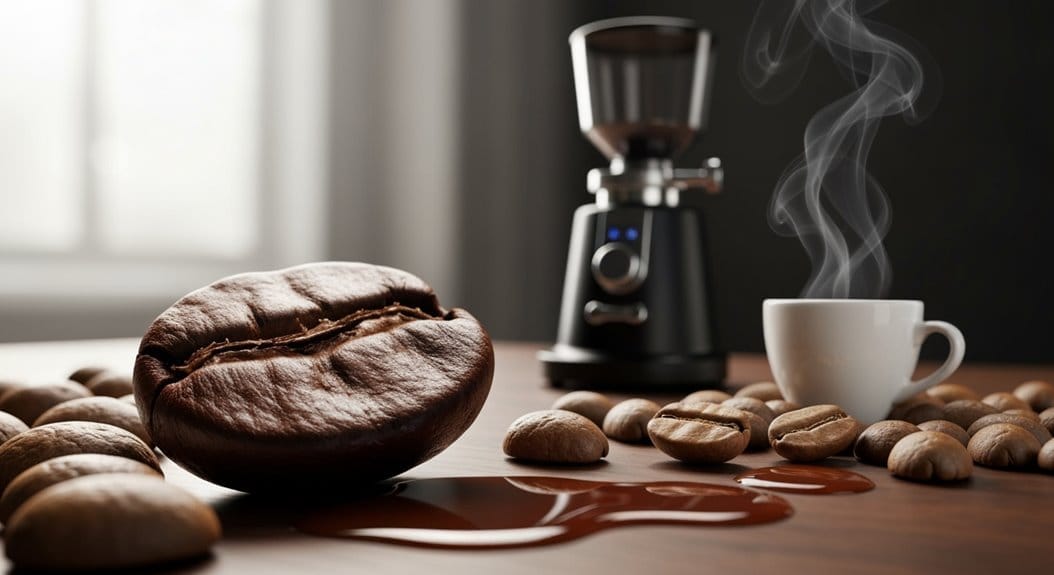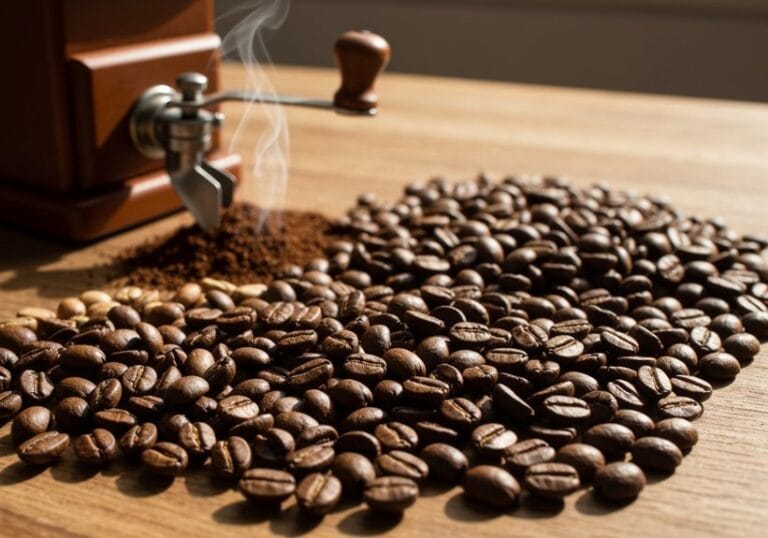In terms of caffeine in coffee, folks often think dark roasts are the heavyweights, but surprise! Caffeine stays pretty steady no matter how dark you go. Yup, darker doesn’t mean stronger! It’s all about how you brew it—like, pouring hot water over coffee grounds is more significant than roast color. So, if you’re counting caffeine, grab a scale instead of a scoop for accuracy; it makes a difference! And hey, there’s more to investigate on this coffee journey!
Key Takeaways
- Caffeine content remains stable across all roast levels; dark roasts do not have more caffeine than lighter roasts.
- Measuring coffee by weight rather than volume ensures accurate caffeine content, as dark roasts are less dense.
- Brewing method and techniques greatly influence caffeine extraction, sometimes more than the roast level itself.
- Arabica beans have a robust flavor profile but contain less caffeine than Robusta beans, which have higher caffeine levels.
- Longer brewing times and optimal extraction techniques can increase caffeine yield, regardless of the roast type.
Understanding Caffeine Content by Roast Level
Many folks hold onto roast myths, thinking darker means more caffeine. Surprise! Caffeine actually stays stable during roasting. Caffeine does not break down during the roasting process, so whether you’ve got a light or dark roast, the total caffeine isn’t really changing much. In fact, the brew method can significantly influence the caffeine extraction. Interestingly, brewing techniques can alter caffeine yield more than the roast level itself! Sure, dark roasts lose weight, making their caffeine concentrated, but it’s only a smidge more than lighter ones!
Darker roasts don’t pack more caffeine—surprise! Caffeine remains stable through roasting, despite popular myths!
Funny how measuring by volume can skew caffeine perception—those denser light beans fit more into a scoop!
Measuring Caffeine: Weight vs. Volume
How on earth do you measure caffeine accurately without losing your mind? Seriously, it’s like trying to solve a Rubik’s Cube blindfolded!
So, here’s the deal: measuring coffee by weight—like grams—gets you that sweet, sweet weight accuracy. Those scoops? Sure, they’re convenient, but guess what? They can totally mess with your caffeine count! Dark roasts puff up like they just got a promotion, which means you get less caffeine per scoop. It’s a caffeine conundrum!
Some folks insist on using a scale for that consistent dosage, while others just wing it. If you’re serious about coffee, remember: weight methods beat volume hands-down for brewing the perfect cup, or you might as well be brewing math problems! Additionally, the roast level significantly impacts the caffeine concentration per bean, so knowing what type you’re working with helps too.
The Role of Extraction Efficiency in Brewing

While brewing a cup of coffee might seem like a straightforward task—just add water to coffee and boom, caffeine heaven!—the truth is that extraction efficiency plays a huge role in determining whether that cup is a delightful pick-me-up or a bitter disappointment.
Brewing coffee is an art; brew it right for a perfect pick-me-up, or suffer a bitter regret!
Think about it!
- The speed of water flow can turn your morning brew from “wow!” to “yikes!”
- Water temperature? It’s basically a caffeine crime scene without the right heat.
- And let’s not forget about particle size since your coffee grounds need to play well together!
With better extraction techniques, you’ll reveal delicious flavors and just the right caffeine punch, making mornings a whole lot less grim. Who doesn’t need that?
Comparing Arabica and Robusta: A Caffeine Showdown
Every coffee lover has faced the age-old question: Arabica or Robusta?
It’s like choosing between a smooth jazz ballad and heavy metal—both have their fans!
Arabica brings that robustness in flavor, while Robusta packs a serious punch with its higher caffeine content.
Important Factors Influencing Caffeine Levels

With regard to the wild world of coffee, factors influencing caffeine levels can feel a bit like a jigsaw puzzle missing half its pieces! Seriously, it’s a head-scratcher!
Factors affecting caffeine levels in coffee can seem like a puzzling mystery, leaving many scratching their heads!
Here’s a taste of what matters most:
- Brewing Variables: Methods and times can drastically change how much caffeine you get! For instance, steeping time significantly affects caffeine extraction; a longer brewing duration can yield more caffeine.
- Bean Characteristics: Different beans have different caffeine levels based on their growing conditions and genetics!
- Roasting Process: Believe it or not, the roast hardly impacts caffeine; it’s all about water weight loss!
Now, it’s funny, right? Many folks think a dark roast = more caffeine, but it’s more about how you brew that cup! Given that espresso shot content is the foundation of an Americano’s caffeine level, the type of beans you choose can also significantly influence the entire caffeine experience.
Frequently Asked Questions
Does Cold Brew Coffee Have More Caffeine Than Hot Brewed Coffee?
Cold brew coffee typically has less caffeine than hot brew due to lower extraction efficiency at cooler temperatures. Despite longer brewing times, the solubility limitations result in lower caffeine levels per volume than hot-brewed coffee.
Can Caffeine Content Vary Between Different Brands of Coffee?
Caffeine content can considerably vary between different brands of coffee. Brand comparison reveals distinct caffeine measurements influenced by bean variety, roasting practices, and brewing methods, affecting total caffeine concentration in the final product served.
What Effect Does Decaffeination Have on Caffeine Levels?
The decaf process effectively reduces caffeine levels by 97% or more, dispelling caffeine myths. Despite this significant reduction, residual caffeine remains, typically ranging from 2 to 12 mg per 8-ounce cup of decaf coffee.
Are There Health Risks Associated With High Caffeine Consumption?
High caffeine consumption poses health risks, including heightened anxiety and cardiovascular issues. Health guidelines suggest monitoring intake, especially in sensitive individuals, as responses vary greatly based on genetics and existing health conditions.
How Does Brewing Time Affect Caffeine Extraction?
Brewing time considerably influences caffeine extraction rates across diverse brewing methods. Longer contact between water and coffee grounds improves extraction, with darker roasts achieving higher rates compared to lighter ones under similar conditions, ultimately affecting caffeine concentration.





